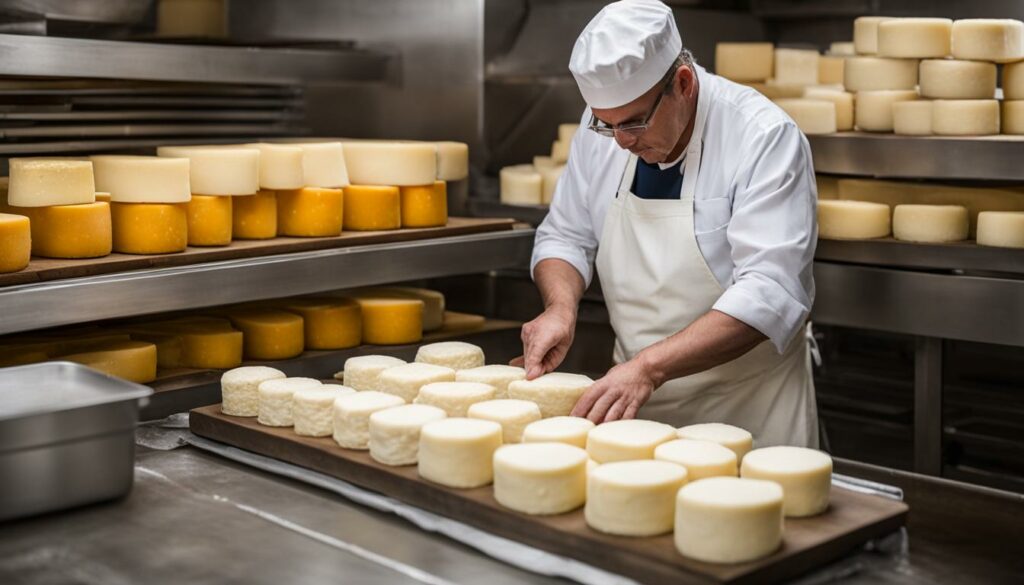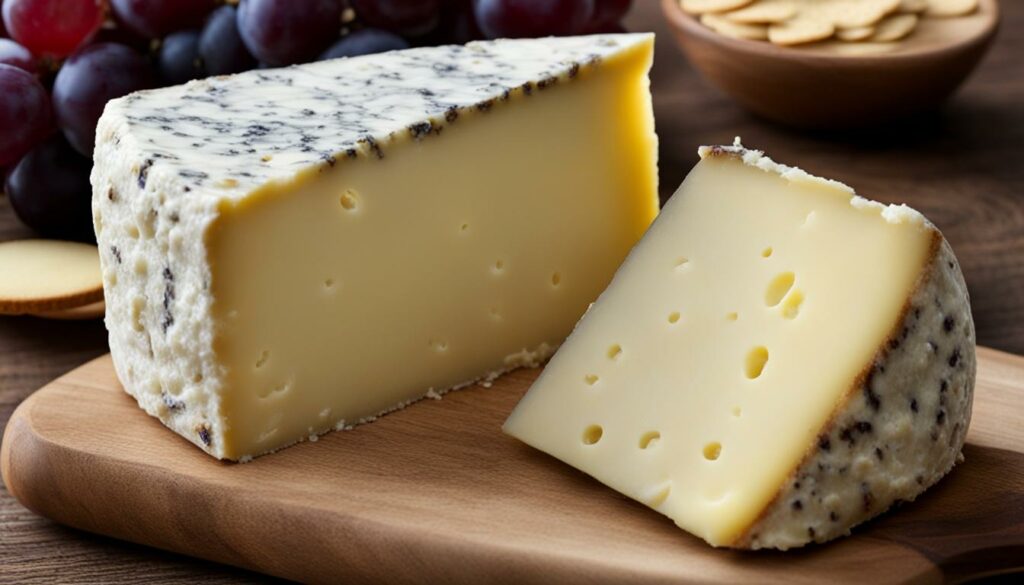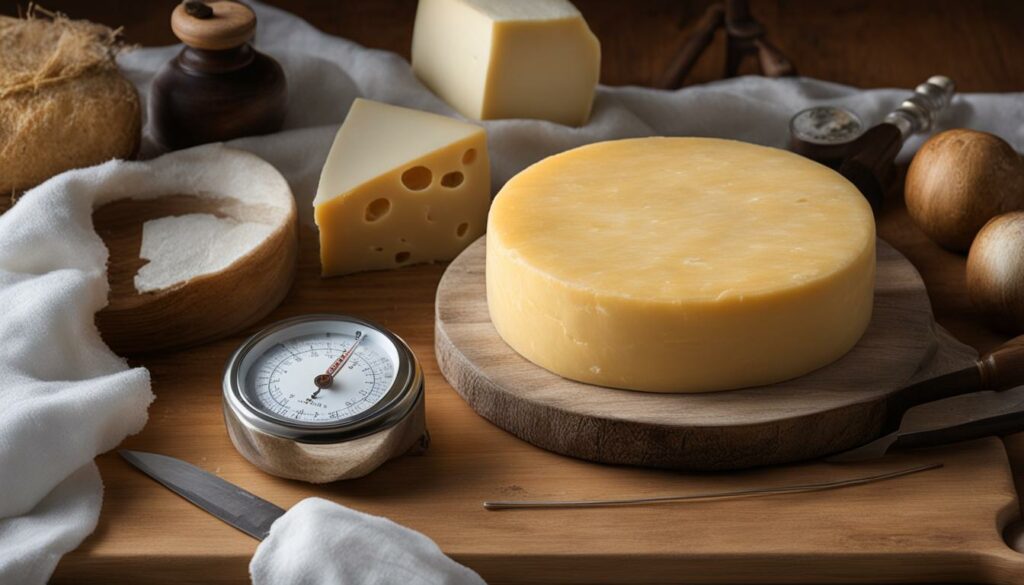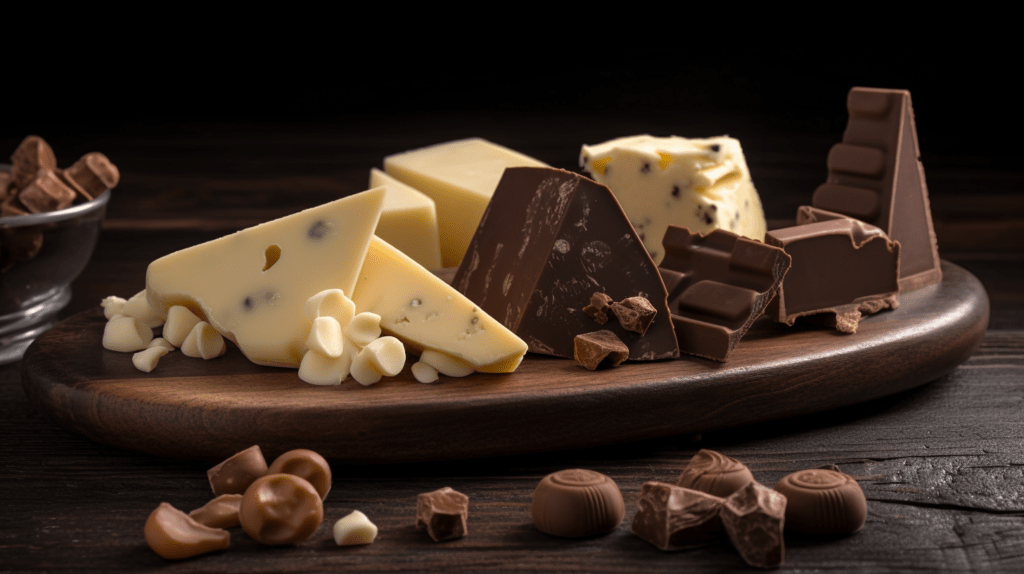Welcome to the world of creamy Lancashire cheese! This beloved British cheese is renowned for its crumbly texture and distinctive flavors. In this article, we will explore the wonderful pairings, delightful recipes, and unique flavors that Lancashire cheese has to offer. Whether you’re a cheese enthusiast or looking for new culinary inspiration, we’ve got you covered.
First, let’s delve into the perfect fruits that complement Lancashire cheese. From refreshing apples to luscious figs, there’s a fruit to suit every palate. We’ll also uncover the wines that beautifully enhance the flavors of the cheese, such as Beaujolais and Pinot Noir. Furthermore, we’ll explore the condiments and accompaniments that add a touch of perfection to your Lancashire cheese experience, like tangy pickles and crusty bread.
But before we take a culinary journey, let’s uncover the rich history of Lancashire cheese. With roots dating back to the 13th century, this traditional British cheese holds a special place in cultural gastronomy. We’ll also reveal the meticulous crafting process that goes into producing Lancashire cheese, resulting in its exquisite texture and complex flavors.
Stay tuned for the variety of flavors Lancashire cheese offers, ranging from young and supple to bold and savory. We’ll also explore the culinary versatility of this cheese, providing you with delectable recipes and ideas to incorporate it into your meals.
Not only is Lancashire cheese a treat for your taste buds, but it also offers numerous nutritional benefits. Rich in calcium and protein, it’s a nutrient-dense choice. We’ll also delve into its sustainability, as producers prioritize waste reduction and sustainable farming practices.
In conclusion, Lancashire cheese is a culinary masterpiece that captivates with its unique flavors, rich history, and versatility. So, come along and explore the world of creamy Lancashire cheese with us, and discover the delightful wonders it has in store for you.
The Perfect Fruits to Pair with Lancashire Cheese
When it comes to pairing the rich and tangy flavors of Lancashire cheese, certain fruits can elevate your taste experience to a whole new level. By combining the creaminess of Lancashire cheese with the refreshing sweetness and nuanced flavors of fruits like apples, grapes, pears, figs, and apricots, you can create a culinary harmony that delights the palate.
Apples
Apples offer a perfect balance to the richness of Lancashire cheese. Their crisp texture and refreshing taste provide a cleansing effect, cutting through the tangy and creamy notes of the cheese. Whether you prefer a Granny Smith for its tartness or a Gala apple for its sweetness, both varieties pair beautifully with Lancashire cheese.
Grapes
For a burst of freshness, try pairing Lancashire cheese with grapes. The sweetness and juiciness of both red and green grapes perfectly complement the saltiness and creaminess of the cheese. Each bite becomes a delightful symphony of flavors that will leave you craving for more.
Pears
The crumbly and slightly acidic nature of Lancashire cheese finds its perfect match in the sweet and aromatic flavors of pears. Ripe and juicy pears, such as Bartlett or Anjou, enhance the overall taste experience, bringing out the best in both the cheese and the fruit.
Figs
Indulge your taste buds with the luscious sweetness of figs, which pair wonderfully with the tanginess of Lancashire cheese. Figs add a luxurious layer of flavor to each bite, creating a harmonious combination that showcases the complexity of both ingredients.
Apricots
Experience the vibrant and slightly tart flavor of apricots alongside the creamy and buttery qualities of Lancashire cheese. Apricots provide a delightful contrast to the cheese, adding complexity and depth to the overall taste profile.

Don’t be afraid to experiment and explore different flavor combinations to find your favorite fruit pairing with Lancashire cheese. The possibilities are endless, and each combination offers a unique taste adventure that highlights the versatility of this beloved cheese.
Wines That Complement Lancashire Cheese
When it comes to pairing wines with Lancashire cheese, you have a variety of options that can enhance the flavors and textures without overpowering this beloved British cheese.
For those who prefer red wine, light-bodied varieties like Beaujolais and Pinot Noir offer an excellent choice. These wines bring out the complexities of Lancashire cheese without overwhelming its delicate notes. The red fruit flavors and earthy undertones of Pinot Noir, in particular, create a delightful combination with young and creamy Lancashire cheese.
If you lean towards white wine, Sauvignon Blanc and Chardonnay are perfect picks. Crisp and refreshing, Sauvignon Blanc provides a complementary counterpoint to the creaminess of Lancashire cheese. Chardonnay, especially from Burgundy or California, pairs exceptionally well with the tangy and crumbly texture of this iconic cheese.
And let’s not forget about Port, a sweet and fortified wine. Its richness and intensity harmonize beautifully with the sharpness of Lancashire cheese, offering a balanced and indulgent experience.
| Wine | Description |
|---|---|
| Beaujolais | Light-bodied red wine with fruity flavors that enhance Lancashire cheese without overpowering it. |
| Pinot Noir | Delicate and earthy, Pinot Noir creates a delightful combination with young and creamy Lancashire cheese. |
| Sauvignon Blanc | Refreshing and crisp, this white wine provides a complementary counterpoint to the creaminess of Lancashire cheese. |
| Chardonnay | Chardonnay from Burgundy or California pairs well with the tangy and crumbly nature of Lancashire cheese. |
| Port | A sweet and fortified wine that balances the sharpness of Lancashire cheese with its rich flavors. |
When choosing a wine to accompany your Lancashire cheese, consider your personal preferences and the specific characteristics of the cheese you’re enjoying. Whether you opt for a light red wine or a crisp white, the right pairing will elevate your culinary experience to new heights.

Condiments and Accompaniments That Complement Lancashire Cheese
When enjoying the delectable flavors of Lancashire cheese, it’s essential to select the perfect condiments and accompaniments that enhance its taste and elevate your culinary experience. Whether you prefer fruity chutneys, tangy pickles, crusty bread, or crispy crackers, there are plenty of options to complement the unique qualities of Lancashire cheese.
Sweet and Tangy Chutneys
Chutneys are a popular choice to pair with Lancashire cheese, offering a delightful blend of sweetness and tanginess that balances the rich and creamy flavors. Fruit-based chutneys, such as apple or mango chutney, provide a tantalizing contrast to the cheese, creating a harmonious combination of tastes.
Tanginess and Crunch of Pickles
Pickles add a tangy and crunchy element to the creamy texture of Lancashire cheese. The contrast between the pickles’ acidity and the cheese’s smoothness creates a vibrant flavor profile that stimulates the taste buds. Consider adding pickled cucumbers, onions, or gherkins to create a perfect balance of flavors.
Crusty Bread and Crackers
To add texture and structure to each delightful bite of Lancashire cheese, serve it with crusty bread or a selection of crispy crackers. The robust crust of the bread complements the cheese’s creamy mouthfeel, while crackers provide a convenient and delicious vehicle to savor the cheese and its accompanying flavors.
Water Biscuits: A Classic Accompaniment
If you prefer a neutral and light accompaniment, water biscuits are an excellent choice to pair with Lancashire cheese. These subtle crackers allow the cheese to take center stage while providing a delicate and crisp base for every delightful bite.
So whether you prefer the sweet tang of chutneys, the satisfying crunch of pickles, the sturdy bite of crusty bread, or the delicate simplicity of water biscuits, there are plenty of condiments and accompaniments to enhance your Lancashire cheese tasting experience.
| Condiment/Accompaniment | Description |
|---|---|
| Chutneys | Sweet and tangy, particularly fruit-based like apple or mango chutney. Complements the flavors of Lancashire cheese. |
| Pickles | Tangy and crunchy, provides contrast to the creamy texture of the cheese |
| Crusty Bread | Texture and structure, complements the creamy mouthfeel of Lancashire cheese. |
| Crackers | Crispy base to enjoy the cheese and its accompanying flavors |
| Water Biscuits | Neutral taste, light texture, perfect accompaniment to let the cheese shine |
The Rich History of Lancashire Cheese
Lancashire cheese has a rich and storied history that dates back to the 13th century. Originating in the county of Lancashire in the North West of England, this traditional British cheese has become an iconic part of the region’s culinary heritage.
What sets Lancashire cheese apart is its succulent, buttery flavor and pliable texture. It is a testament to the mastery of dairy craftsmanship that has been passed down through generations, as cheese makers continue to uphold the traditional methods that make this cheese truly exceptional.
“Lancashire cheese is a culinary treasure that showcases the artistry and expertise of the cheese makers in the UK. Its rich history and unique flavor profile have made it a beloved cheese among cheese enthusiasts around the world.”
Today, Traditional Lancashire cheese remains a cornerstone of the British cheese industry and a source of cultural pride for the people of Lancashire. It is a testament to the enduring legacy of artisanal cheese making and the commitment to preserving culinary traditions.

Whether enjoyed on a cheese platter, melted into a savory dish, or paired with a glass of wine, Lancashire cheese continues to captivate taste buds and delight palates with its rich history and unparalleled flavor.
The Crafting Process of Lancashire Cheese
The traditional process of crafting Lancashire cheese involves a meticulous cheddaring technique. It all starts with high-quality cow’s milk sourced from the lush pastures of Lancashire. The milk is gently pasteurized to ensure its safety and quality.
Once pasteurized, cultures and rennet are added to the milk, kickstarting the coagulation process. This combination causes the milk to separate into curds and whey. The curds, which will eventually become the cheese, are carefully cut to release more whey and create the desired texture.
The next step involves pressing and layering the curds to further develop their texture. This process allows the curds to expel moisture and form a cohesive mass. It’s during this stage that the cheddaring technique – an art mastered by skilled cheesemakers – takes place.
The curds are stacked and turned multiple times, aiding in the expulsion of whey and facilitating the development of Lancashire cheese’s distinct crumbly texture. This meticulous process allows for the creation of complex flavors and ensures the cheese’s consistency throughout.
After the curds have been properly cheddared, they are molded into cylindrical shapes and left to mature. During the aging period, which can range from a few weeks to several months, the cheese develops its characteristic flavors and texture.
The result of this intricate process is an exquisitely balanced Lancashire cheese that captures the essence of its rich heritage and craftsmanship.
| Step | Description |
|---|---|
| 1 | Sourcing high-quality cow’s milk |
| 2 | Pasteurizing the milk |
| 3 | Adding cultures and rennet to coagulate the milk |
| 4 | Cutting the curds and releasing whey |
| 5 | Pressing and layering the curds |
| 6 | Carefully cheddaring the curds |
| 7 | Molding the curds and allowing them to mature |
Image:

The Variety of Flavors in Lancashire Cheese
Lancashire cheese offers a delightful range of flavors, with various options to suit every palate. Whether you prefer the delicate milky notes of young Lancashire cheese or the bolder, savory character of the tasty variety, there is a flavor profile to satisfy your cravings.
Young Lancashire cheese is known for its supple texture and gentle flavor. With its creamy and milky taste, this cheese is perfect for those seeking a milder experience. It pairs well with a variety of flavors and can be enjoyed on its own or as part of a cheeseboard.
If you prefer a more robust and pronounced flavor, opt for the tasty Lancashire cheese. This variety boasts a firmer body and a bold character that is sure to impress your taste buds. The aging process adds depth and complexity to the cheese, resulting in savory notes that linger on the palate.
Comparison of Young and Tasty Lancashire Cheese
| Flavor | Texture | Pairings |
|---|---|---|
| Youthful Milky Flavor | Supple | Fresh fruits, light white wines, crusty bread |
| Bold and Savory Character | Firm | Red wines, chutneys, pickles, hearty bread |
The Aging Process
The unique flavor profiles of Lancashire cheese are achieved through a meticulous aging process. As the cheese matures over time, it develops its distinct characteristics, which are greatly influenced by factors such as temperature, humidity, and storage conditions. The longer the aging period, the more pronounced the flavors become.

Young Lancashire cheese entices with its delicate milky flavor, while the tasty variety offers a bold and savory experience. Whether you prefer a subtle or robust taste, Lancashire cheese has something to suit every palate.
The Culinary Versatility of Lancashire Cheese
Lancashire cheese is not only delicious on its own, but it also shines when paired with a variety of sweet and savory accompaniments. With its exceptional flavor and texture, Lancashire cheese can elevate a range of culinary dishes, from simple cheeseboards to intricate sauces and gratins.
When it comes to enjoying Lancashire cheese, the possibilities are endless. Here are some ideas to get you started:
1. Cheeseboards:
Create a stunning cheeseboard with a selection of Lancashire cheese, complemented by fresh fruits, nuts, and artisan crackers. The creamy and tangy flavors of the cheese perfectly balance the sweetness of fruits like grapes and the crunchiness of almonds.
2. Sandwiches:
Add a slice of Lancashire cheese to your favorite sandwich for a burst of flavor. Whether paired with roasted vegetables, cured meats, or tangy condiments, Lancashire cheese brings richness and depth to every bite.
3. Sauces and Gravies:
Incorporate Lancashire cheese into your homemade sauces and gravies to enhance their creaminess and add a hint of tang. Whether it’s a classic cheese sauce for pasta or a rich gravy for meats, the distinct flavors of Lancashire cheese will take your dishes to the next level.
4. Gratins and Casseroles:
Layer slices of Lancashire cheese between potatoes or vegetables in gratins and casseroles, creating a delectable cheesy crust. The cheese melts beautifully, infusing the dish with its rich, buttery taste.
Ready to explore the delicious world of Lancashire cheese? You can find this versatile cheese online or at specialty cheese shops. Try different varieties and experiment with your own Lancashire cheese recipes to discover new culinary delights!

Lancashire Cheese’s Place in Cultural Gastronomy
Lancashire cheese holds a distinguished place in British culinary tradition. It is celebrated for its rich cultural heritage and regional pride. Lancashire cheese goes beyond being a product; it is a narrative woven through centuries. It embodies the liberty of culinary expression and cherished traditions of its homeland.
Nutritional Benefits and Sustainability of Lancashire Cheese
Lancashire cheese is not only a delectable delight but also packed with essential nutrients, making it a wholesome choice for cheese enthusiasts. It’s renowned for its nutrient-dense profile, providing a rich source of calcium and protein.
If you’re lactose intolerant, fret not! Aged varieties of Lancashire cheese are typically lower in lactose content, making them more suitable for individuals with lactose intolerance.
But it’s not just about the nutritional benefits. Producers of Lancashire cheese are passionate about sustainable farming and environmentally-friendly practices. They prioritize waste reduction, implement energy-efficient processes, and adopt sustainable farming techniques to minimize their ecological impact. By choosing Lancashire cheese, you can indulge in a culinary experience that aligns with your values.
Conclusion
Lancashire cheese is undeniably a culinary masterpiece that delights the senses with its unique flavors and textures. With its rich history and meticulous crafting process, this beloved British cheese has earned its place among the finest culinary creations. Whether enjoyed in traditional recipes or experimented with in innovative dishes, Lancashire cheese showcases its versatility and adds a touch of elegance to any dining experience.
The cultural significance of Lancashire cheese cannot be overstated. With each bite, you savor not just a delicious cheese but also the heritage and pride of a region. Lancashire cheese is a testament to the mastery of dairy craftsmanship that has been passed down through generations, culminating in a true culinary gem. Its place in cultural gastronomy is firmly rooted, treasured, and celebrated.
Additionally, Lancashire cheese stands out not only for its exceptional taste but also for its commitment to sustainability. Producers of this delectable cheese prioritize waste reduction, energy efficiency, and sustainable farming practices. This ensures that Lancashire cheese satisfies not only your culinary cravings but also your conscience, with minimal ecological impact.
Experience the magic of Lancashire cheese and discover why it is cherished worldwide as one of the finest culinary creations. Indulge in the rich flavors, explore its versatility in various recipes, and appreciate the cultural heritage and sustainable practices that come together to create this culinary masterpiece. Lancashire cheese is truly a delight to be savored and celebrated with every bite.
FAQ
What is Lancashire cheese?
Lancashire cheese is a beloved British cheese known for its crumbly texture and distinctive flavors. It is a traditional cheese that originated in the county of Lancashire in the North West of England.
What are the best fruits to pair with Lancashire cheese?
Apples, grapes (both red and green), pears, figs, and apricots are excellent fruits that complement the unique qualities of Lancashire cheese. These fruits provide a refreshing balance, burst of freshness, and luscious sweetness that harmonize with the tanginess and creaminess of the cheese.
Which wines go well with Lancashire cheese?
Light red wines like Beaujolais or Pinot Noir, crisp white wines such as Sauvignon Blanc or Chardonnay, and sweet fortified wines like Port enhance the flavors of Lancashire cheese without overpowering it. Chardonnay from Burgundy or California and Pinot Noir’s red fruit flavors and earthy notes create delightful combinations with the different varieties of Lancashire cheese, while Port balances the sharpness of the cheese with its rich flavors.
What condiments and accompaniments go well with Lancashire cheese?
Sweet and tangy chutneys, particularly fruit-based ones like apple or mango, complement the flavors of Lancashire cheese. The tanginess and crunch of pickles provide a delightful contrast to the creamy texture of the cheese. Crusty bread and crackers add texture and structure to each bite of Lancashire cheese, with water biscuits being an excellent accompaniment due to their neutral taste and light texture.
What is the history of Lancashire cheese?
Lancashire cheese has a rich history dating back to the 13th century. It is a traditional British cheese that originated in the county of Lancashire in the North West of England. It is esteemed for its succulent, buttery flavor and pliable texture, embodying the mastery of dairy craftsmanship passed down through generations.
How is Lancashire cheese made?
The traditional process of crafting Lancashire cheese involves a meticulous cheddaring technique. High-quality cow’s milk from the pastures of Lancashire is gently pasteurized. Cultures and rennet are added to coagulate the milk into curds and whey. The curds are then cut, pressed, and layered to achieve the cheese’s complex texture. The result is an exquisitely balanced Lancashire cheese.
What are the different flavors of Lancashire cheese?
Lancashire cheese comes in various forms, including young and tasty varieties. Young Lancashire cheese is supple with a delicate milky flavor. Tasty Lancashire cheese presents a firmer body and a bolder character with savory notes. The aging process gives Lancashire cheese its unique flavor profiles.
How can I use Lancashire cheese in my cooking?
Lancashire cheese can be used in a variety of culinary dishes, from cheeseboards and sandwiches to sauces and gratins. You can purchase Lancashire cheese online or at specialty cheese shops to explore different recipes that feature Lancashire cheese as a key ingredient.
What is the cultural significance of Lancashire cheese?
Lancashire cheese holds a distinguished place in British culinary tradition. It is celebrated for its rich cultural heritage and regional pride. Lancashire cheese goes beyond being a product; it is a narrative woven through centuries. It embodies the liberty of culinary expression and cherished traditions of its homeland.
Are there any nutritional benefits or sustainability aspects of Lancashire cheese?
Lancashire cheese is nutrient-dense, rich in calcium and protein. Aged varieties of cheese are suitable for those with lactose intolerance. Producers of Lancashire cheese focus on waste reduction, energy efficiency, and sustainable farming practices, making it a culinary delight with minimal ecological impact.
Why is Lancashire cheese considered a culinary masterpiece?
Lancashire cheese is a culinary delight with its unique flavors and textures. It has a rich history, a meticulous crafting process, and a versatile nature. Lancashire cheese is a beloved ingredient in both traditional and innovative recipes. Its cultural significance and commitment to sustainability make it a true culinary masterpiece.







